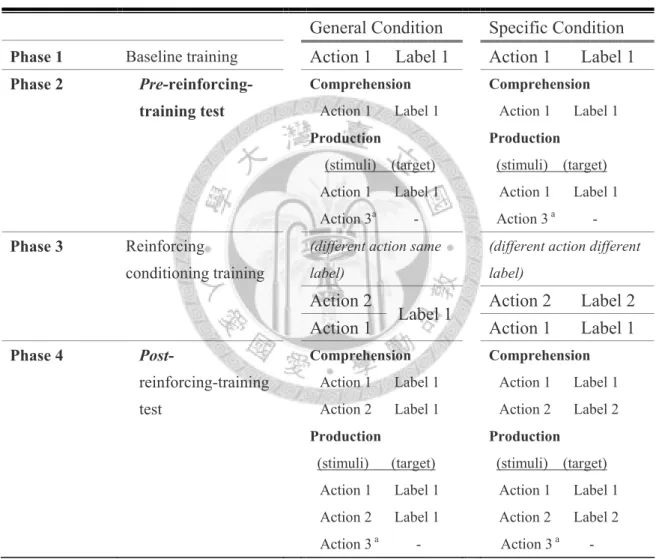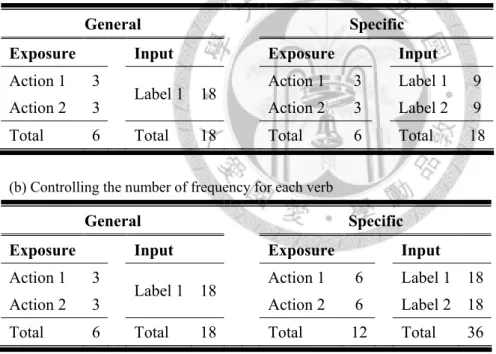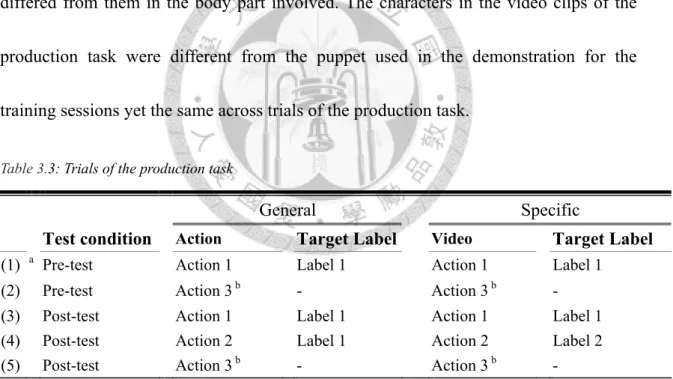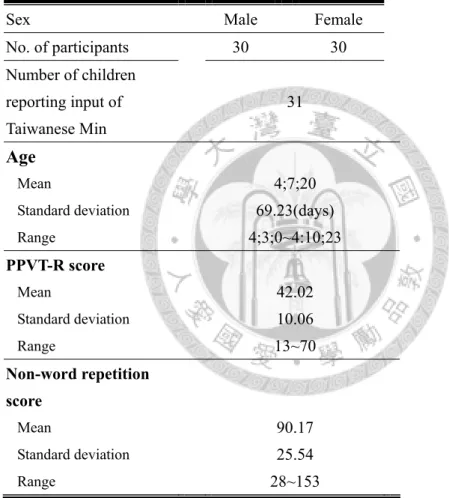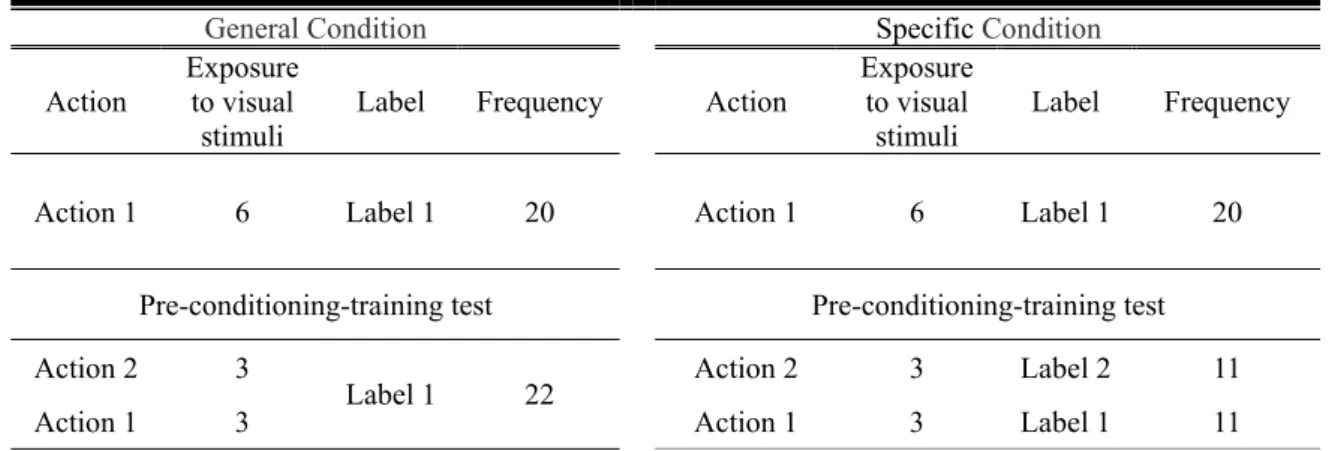國立臺灣大學文學院語言學研究所 碩士論文
Graduate Institute of Linguistics College of Liberal Arts
National Taiwan University Master Thesis
詞彙特指性與詞彙習得之探討
Lexical Specificity and Lexical Acquisition
陳素玫 Su-Mei Chen
指導教授:張顯達 博士 Advisor: Hintat Cheung, Ph.D.
中華民國 九十八 年 七 月
July, 2009
致謝
這篇論文能夠完成,要感謝許多幫助我的人。首先要感謝台大語言所每一位師長的提 拔及教導。蘇以文老師及江文瑜老師在我們一進到這個大家庭,就引領著我們一窺語言學 研究的奧妙;宋麗梅老師在我還未正式踏入語言所時,就願意讓我從旁學習,使我獲益良 多,而在田野調查課程中,宋老師用爽朗的笑聲帶領我們走進南島語言的研究;安可思老 師不只訓練我們在學術領域的研究方法與態度,也讓我們重新認識自己,並一步步規劃未 來;馮怡蓁老師在課堂之餘十分親切,但在研究以及課堂上一絲不苟的態度也是我學習的 典範,尤其是統計以及研究方法的訓練,讓我在實驗結果的分析上能夠更加嚴謹;黃宣範 老師對學術的熱愛與奉獻,總是激勵著我們不斷前進,老師在認知語意學課堂上的教導,
也讓我對詞彙語意學的認識更深入,使我在探討語意學議題時能夠更完整。最要感謝的是 我的指導教授─張顯達老師。大四時從老師的課堂上,開始領略語言習得領域研究的樂趣,
而這段時間我在這個領域上的小小成長,也要感謝老師的指導。感謝老師在被各種計畫與 會議淹沒的百忙之中,仍然願意抽出時間指導我,不論多忙,老師總是盡力幫我檢視目前 的成果,耐心地指引我論文下一步的方向。另外,也非常謝謝老師提供我擔任教學助理以 及研究助理的機會,讓我有機會能參與不同的研究計畫,學習如何面對問題、解決問題。
非常感謝兩位口試委員:台北市立教育大學英語教學系的胡潔芳老師及台大心理系的 曹峰銘老師,願意在百忙之中抽空審閱這篇論文,提供許多重要的建議與新的思考方向,
使得這篇論文更加完整。另外,這篇論文中實驗資料的完成最主要是得力於溪口國小附幼、
懷恩幼稚園、新佳美幼稚園、武功國小附幼、荳荳幼稚園、惠生幼稚園、及聖愛幼稚園的 園長、老師及小朋友的大力協助與合作,園長、老師們的打氣及小朋友的熱情招呼,是支 持我將近兩個月拉著行李箱趕場作實驗的動力;園長、老師們的親切和小朋友們的天真臉 龐,也使得這段看似辛苦的日子成為令人懷念的回憶。
之所以踏入語言學這個領域,要感謝台大外文系的胥嘉陵老師,老師生動的語言學概 論課程,點燃了我對語言學的興趣;還要感謝中研院的齊莉莎老師和曾淑娟老師,當時雖 然熱情被點燃,但是還是有一些徬徨,多虧了老師的鼓勵,讓我更勇敢地前進。我也要感 謝台大人類系的陳瑪玲老師和陳伯楨老師,從大學到現在一直都很關心我,並提供我助理 的工作,使我在學習與研究之餘,沒有後顧之憂,另外,也感謝陳伯楨老師的考古學量化 方法課程,讓我對統計軟體與理論的結合更加得心應手,在撰寫這篇論文時也節省了不少 摸索的時間。
感謝台大語言所的所有所胞、戰友們的陪伴與鼓勵。感謝95 級的所有同學們,尤其是
沙拉、小安、Ruby,讓這戰戰兢兢的三年更加有趣,我不會忘記那些一起做報告、一起出 田野、一起聊天、一起紓壓、一起玩耍的日子,有你們在身邊,總是歡笑不斷。感謝學長 姊們的鼓勵和支持,尤其是惠如學姐、立心學姐、季樺學姐、芷誼學姐、郁婷學姐、宜萱 學姐、雪莉學姐、人鳳學姐、沙力學姐、和盛秀學姐,常常關心我的論文進度,也給了情 緒起伏很大的我重要的安定力量。感謝學弟妹們的加油打氣,你們的熱情,我都收到了。
lab 胞們更是我遇到瓶頸時最好的諮詢與求救對象,尤其是乃欣學姐從我進實驗室到畢業,
一直鼓勵著我,在我論文分析遇到問題時,比我還認真、歪著頭的思考模樣,讓我很感動,
而這篇論文中針對受試者非詞覆誦的資料,也感謝學姐幫忙分析給分;溫柔的珊如學姐總 是很有耐心地面對我各式各樣的疑難雜症,給我許多受用的建議;謝謝姚姚、妙茹在我低 落時給我力量,很高興能和你們一起畢業;美璇學姐、佳霖學姐和涂媛學姐在鼓勵我之餘,
常給我研究上的建議;佩玥時常傾聽我各種牢騷,很喜歡和妳沒有壓力地聊天;Echo 認真
幫我尋找受試者,也認真的教我一起「補疵啪疵」;謝謝你們。還要感謝美玲和劉姐,進到
301 室總是先領取到妳們大大的微笑,無論多麼瑣碎的事,一直都很有耐心地幫助我們。
最後要謝謝我最重要的家人,一直信任我、陪伴我的媽媽、大哥和二哥。謝謝一路上 所有曾經給我勇氣和祝福的人,謝謝你們,讓我能有機會謝謝你們。
摘要
本研究旨在探索詞彙語意上的特指性是否影響動詞習得。Tardif (2006)曾指出 中文動詞比起英文動詞,因其語意特指性較高而較易習得。中文的動詞是否較特 指尚無定論,本研究要檢驗的則是,以一般新詞學習歷程而言,特指性較高的動 詞是否較易習得;主要關注當語言對於不同動作給予命名上的對比(即給予特指
性高的詞彙),是否因此促進詞彙學習;另外,本研究也檢視學習不同語意特質詞
彙的幼兒,是否發展出不同延伸新詞到其他情境上(extension)的策略。
本研究藉由對於相同視覺刺激的給予不同命名方式,來操控新詞的語意特指 性。本研究採用快速對應作業(fast-mapping task),受試者需要將聽到的新詞與看 到的動作作對應。在訓練階段,受試者會看到實驗者現場示範數次新動作,並從 指導語中聽到新詞,實驗組別分為特指組與泛指組。不同組別之間,語言刺激的 次數及動作示範次數皆相同;兩組主要的分別在於對動作之命名的差異性。在特 指組中,兩個不同的動作,會被對應到兩個新詞;而在泛指組中,這兩個動作會 被對應到同一個新詞。訓練與測試分為四個階段,第一階段兩組幼兒都聽到同一 詞彙對應到同一動作;第二階段進行兩組幼兒的前測,作為比較的控制組;第三 階段兩組幼兒都看到另一個類似的動作,泛指組幼兒會聽到與第一階段相同的新 詞去指稱,而特指組幼兒則聽到另一個不同的新詞去指稱該動作;第四階段為後 測,檢驗第三階段兩組別中不同的命名方式是否對幼兒表現造成影響。測驗包含 理解測驗與說話測驗,以影片方式進行;理解測驗要求受試者選出與命名相配合 的影片,說話測驗則要求受試者回答該段影片的主角做了什麼。
本研究受試者包含六十名平均年齡約四歲半的幼兒。結果顯示,即使特指組 幼兒在訓練階段聽到比泛指組幼兒聽到較多新詞,但不見得能夠因此在適當情境 說出較多的詞彙;說話測驗的結果顯示,特指組幼兒對原詞彙的表現,在後測階 段的表現比前測階段顯著退步,而泛指組幼兒則表現穩定。雖然特指組幼兒對語 意已有初步認識,但大多無法區辨兩個新詞的語意範圍。另一方面,本研究也發 現泛指組的訓練促進了新詞延伸,而特指組則不然,同時,施測順序以及幼兒詞 彙量對於新詞延伸策略亦有影響,若幼兒先受過特指性高動詞的訓練或擁有較大 詞彙量,延伸新詞的比例較低。另外,我們也探討了詞彙量、音韻工作記憶的個 別差異及施測順序,如何影響幼兒在本實驗的理解作業的表現,我們發現在泛指 組中詞彙量較高的幼兒表現顯著優於詞彙量較低的幼兒,音韻工作記憶的個別差 異並未造成表現上顯著的差別。總結來說,本研究支持幼兒對詞彙語意的習得是 一個動態的過程,幼兒對語意的假設,不斷受到語言經驗的影響及型塑。
關鍵詞:語意特指性,語意分類,詞彙習得,詞彙發展,動詞習得,快速對應
Abstract
This present study aims to explore the impact of specificity on Mandarin-speaking children’s verb learning process. Tardif (2006) proposed that the typologically higher specificity of Mandarin verbs contributes to the ease of learning and thus leads to higher proportion of Mandarin verbs in early vocabulary. It remains unclear whether Mandarin verbs are more typologically specific, while this study examined the role of specificity in the general mechanism of lexical acquisition. This study aims to explore whether providing children with an additional label to mark a semantic distinction facilitates word learning. In addition, it was also examined whether different labeling patterns would contribute to different strategies for extending novel words.
This study manipulated specificity of novel words by providing different labeling patterns for the same visual stimuli. Specificity was thus defined as the presence of labels marking the distinction between two different actions in contrast with a single label for both actions. The experimental conditions included the General Condition and the Specific Condition. In the General Condition, two actions were mapped onto one word whereas in the Specific Condition these actions were mapped onto two words. The main experiment for testing specificity effect can be divided into four phases: (1) the baseline training, (2) the pre-conditioning-training test, (3) the reinforcing conditioning training, and (4) the post-conditioning-training test. In the first phase, all the participants were shown an action labeled by a novel word. In the second phase, they were tested with the aid of video clips. Then came the third phase in which the children were shown with a different but similar action that was labeled by either the same label (in the General Condition) or a different label (in the Specific Condition). Finally, in the fourth phase, the participants were tested for their production and comprehension of the novel words.
Children’s production, understanding about semantic distinctions, and the pattern of extending uses of novel words were examined. Sixty 4.5-year-old Mandarin-speaking children participated in this study. Results indicated that children under the Specific Condition were not significantly more likely to produce an additional target word although they heard more words in the training session. They performed poorer on the baseline verb in the post-test than in the pre-test whereas this retrogress was not found in the General Condition. Although children had a robust understanding about specific words, most of them failed to make correct distinction between these specific words. As for extending uses of novel words, results revealed that the training of a general word facilitated extension, yet the training of specific words did not. Additionally, an influence of vocabulary size and order effects were found in the extension task:
Children with larger vocabulary and children exposed with a prior training of specific verbs were much less likely to extend novel words to other novel actions. Also, we examined how individual differences affected children’s performance in this particular novel word learning task. Results showed that children with larger vocabulary performed significantly better in the comprehension task than children with smaller vocabulary when learning a general word whereas the difference did not exist when children were presented with specific words. Taken all together, our results supported the view that word learning is a dynamic process in which the semantic boundaries are shaped by children’s language experience.
Key words: semantic specificity, semantic category, lexical acquisition, lexical
development, verb learning, fast mappingTable of Contents
List of Tables ...iv
List of Figures...v
Chapter 1. Introduction...1
1.1 Background ...1
1.1.1 Lexical specificity in meaning ...1
1.1.2 Challenges to applying specificity hypotheses to acquisition issues ...4
1.1.2.1 Specificity in terms of cross-linguistic evidence...5
1.1.2.2 Specificity within a certain language...7
1.1.3 Probe into the effect of specificity: Vocabulary size, time or understanding about word meaning? ...8
1.2 Purpose, design and research questions ...10
1.2.1 Factor examined: Specificity...10
1.2.2 Specificity vs. frequency...12
1.2.3 Related issues: Extending uses of novel words...12
1.2.4 Other factors involving linguistic experience ...13
1.2.5 Research questions...13
1.3 Significance...14
1.4 Organization...15
Chapter 2. Literature Review ...16
2.1 Is Chinese a verb-friendly language?...16
2.2 Why do verbs in languages like Chinese not show a delay? ...17
2.2.1 Syntactic properties that make verbs more salient in input...18
2.2.2 Frequency...18
2.2.3 Social learning, cultural factor, or pragmatic context ...19
2.2.4 Perceptual Salience ...20
2.3 Specific hypothesis and lexical acquisition ...20
2.3.1 Previous studies on specificity and processing ...21
2.3.2 Typological pattern in specificity and lexical development...26
2.4 The interaction between specificity and frequency ...38
Chapter 3. Experimental Designs and Experimental Tasks...40
3.1 Experimental Design...42
3.1.1 Variables...42
3.1.2 Counterbalancing ...43
3.1.3 Confounding factor: Input frequency...44
3.1.4 Production task...46
3.1.5 Comprehension task...47
3.1.6 Levels of analyses ...49
3.2 Participants...50
3.3 Materials ...51
3.4 Procedure ...53
3.4.1 Vocabulary size: Peabody Picture Vocabulary Test-Revised ...53
3.4.2 Phonological working memory: Non-word repetition task...53
3.4.3 Training phase ...55
3.4.3.1 The breaking action ...57
3.4.3.2 The carrying action...57
3.4.4 Test Phase...58
3.4.4.1 Production test ...58
3.4.4.2 Comprehension test ...59
Chapter 4. Results on Specificity Effect ...61
4.1 Production task...62
4.1.1 Performance in each trial testing novel word...62
4.1.2 Number of target words produced...66
4.1.3 The pattern of extension of the novel word ...70
4.1.3.1 Results from McNemar tests for each condition ...70
4.1.3.2 Order effect in the extension task ...71
4.1.3.3 Performance of children with different vocabulary sizes...75
4.2 Comprehension task...77
4.2.1 Comparison against chance level...77
4.2.2 Performance on the baseline verb: From pre-tests to post-tests...78
4.2.3 The role of individual differences in the comprehension task ...79
4.2.3.1 Vocabulary size...79
4.2.3.2 Phonological working memory ...82
4.2.3.3 Correlation between age, PPVT, non-word repetition, and
comprehension...84
4.2.3.4 Regression analyses...85
4.2.4 Order effect in the comprehension tasks...86
4.3 Summary of results ...90
Chapter 5. General Discussion and Conclusion ...91
5.1 Does providing labels for contrasts between actions facilitate word learning in production and comprehension? ...91
5.2 Are children learning specific words less likely to extend the use of novel words? ...94
5.3 Word learning as a dynamic process...97
5.4 Future study ...98
5.4.1 Syntactic factors...98
5.4.2 The role of individual difference...99
5.4.3 Specificity on a continuum ...99
5.4.4 The role of frequency...100
References...101
Appendices...106
Appendix 1: Counterbalancing of the two actions shown in the training session ...106
Appendix 2. Actions adopted in the training sessions ...107
Appendix 3. Video clips in test trials in the comprehension task ...108
Appendix 4. Video clips in test trials in the production task ... 112
Appendix 5. Instructions in the training sessions ... 114
List of Tables
Table 3.1: Experimental design: Stimuli in each training and test phase ...41
Table 3.2: Different designs for mapping in the conditioning training session...46
Table 3.3: Trials of the production task ...47
Table 3.4: Trials of the comprehension task...49
Table 3.5: Two groups of actions...52
Table 3.6: The characteristics of participants ...55
Table 3.7: The frequency of visual and linguistic stimuli ...57
Table 4.1: The number and proportion of target responses in the production task ...64
Table 4.2: Performance on the baseline verb in the production task (pre-test and post-test) ...66
Table 4.3: The number of children producing no, one or two target words in the test sessions ...67
Table 4.4: The pattern of lexical gain from pre-test to post-test...70
Table 4.5: The number and proportion of responses of novel words in the extension task...71
Table 4.6: Responses of novel words in the extension task and the order of presentation of stimuli ...74
Table 4.7: The number of children with different vocabulary sizes measured by PPVT-R...75
Table 4.8: Crosstabulation of responses to the extension task and the group of vocabulary size ...77
Table 4.9: Accuracy and the binominal tests in the comprehension task ...78
Table 4.10: Performance on the baseline verb in the comprehension task (pre-test and post-test) ...79
Table 4.11: Comprehension scores of children with larger vocabulary and smaller vocabulary ...81
Table 4.12: The number of children with larger and smaller phonological working memory size...82
Table 4.13: Comprehension scores of children with larger and smaller phonological working memory size measure by a non-word repetition task...83
Table 4.14: Correlation matrix for subject variables and dependent variables ...85
Table 4.15: The hierarchical multiple regression analyses with comprehension score as the dependent variable...86
Table 4.16: Comprehension scores of groups with different orders of presentation of stimuli ...89
List of Figures
Figure 3.1: Demonstration in the training phase of the breaking action ...52 Figure 3.2: Styrofoam used in the breaking action ...52 Figure 3.3: Demonstration in the training phase of the carrying action...53 Figure 3.4: Circles hung on several “branches” separately (in the carrying action)...58 Figure 3.5: Example for the video clips used in the production task ...59 Figure 3.6: Example for the video clips used in the comprehension task...60 Figure 4.1: The mean scores of groups with different vocabulary sizes for each
condition...81 Figure 4.2: The mean scores of groups with different non-word repetition scores for
each condition ...84 Figure 4.3: The mean scores of groups with different non-word repetition scores for
each condition ...89
Chapter 1. Introduction
1.1 Background
1.1.1 Lexical specificity in meaning
Semantic specificity of a word1 can be defined as the amount of information that
the word encodes or the degree to which the word encodes (Gentner, 1981; Tardif,
2006a, 2006b). It is also known as “semantic weight” (Barde, Schwartz, & Boronat,
2006), “semantic complexity”, or “semantic richness”(Gordon & Dell, 2003). Also,
some researchers have defined semantic complexity as the number of semantic features
that a word has (Breedin, Saffran, & Schwartz, 1998).
An influential body of studies has provided cross-linguistic evidence that
languages differ in how they encode meanings into words (Choi & Bowerman, 1991;
Talmy, 1985) For example, Talmy (1985) provided evidence for a variety of patterns of
lexicalization across languages on the basis of findings from motion verbs, which were
analyzed into small semantic components. Similarly, Tardif (2006a, 2006b) also argued
that Mandarin encodes more information into verbs when compared to English.
The notion of specificity in previous studies mentioned above is based on the
1 In this study, the terms, “semantic specificity”, “lexical specificity”, and “specificity”, were applied to refer to the narrowness or limitedness of meaning that a particular word has.
lexicalization or packaging of word meaning; some researchers, however, interpret the
mapping between a word and its meaning on the basis of the notion of categorization or
semantic partitioning (Bowerman, 2005; Choi, McDonough, Bowerman, & Mandler,
1999). That is, this alternative framework involving “categorization” is also adopted to
interpret the contrast between specificity and generality of word meaning. The degree of
specificity is thus linked to “category size” (Bowerman 2005, p.225): Higher specificity
of a word implies a smaller category.
It has also been suggested that different languages draw different semantic
boundaries on the outside world, even for natural boundaries. Take color terms for
example. English has two distinct terms for green and blue yet some other languages
have a single term to cover those colors which are referred to by two terms in English.
On the other hand, Russian has two separate words for light blue and dark blue while
this distinction does not reflect in English (Berlin, 1969).
Cross-linguistic evidence has already shown that even based on the same ability to
perceive the world, typological differences exist in the pattern of lexicalization or
semantic partitioning, yet when involving the process of acquisition, this issue would be
even more complex. This study was originated from the argumentation that Mandarin
verbs are friendlier for children in that they are more typologically specific (Tardif,
2006a, 2006b). The argument that the ease of Mandarin verb acquisition comes from
their high specificity is based on the assumption that specific verbs are easier to be
acquired and the assumption that Mandarin verbs are specific. This study aims to test
the first assumption, which involves the general mechanism of lexical acquisition.
Nevertheless, though the second one is not the main focus of this study, it will be also
discussed later for an overall review.
Whether specificity facilitates word learning remains unclear, and some
researchers have argued otherwise that general verbs may be easier and specific verbs
could be harder. Clark (1973), for instance, proposed a “semantic feature hypothesis”,
suggesting children begin with general features and then narrow down the referent of a
word gradually by adding more specific semantic features to the word. If children
acquire semantic features gradually as argued by Clark, high specificity may impede a
full understanding of word meaning in an early stage of word learning. In addition,
extremely high specificity may confuse children in that more semantic distinctions
should be detected and learned to master this semantic complexity. For example, when
using a verb denoting carrying actions, children acquiring Tzeltal and Chinese need to
make distinctions between positions of the object being carried corresponding to the
agents’ parts (Brown, 2001; Tardif, 2006a). Moreover, high specificity may obstruct
children’s understanding about the meaning of a word since cues of perceptual
differences may not be available for children to analyze the meaning of a new word.
Also, empirical evidence has showed that many general words, such as go, make, and
put, appear in the early vocabulary. Ninio (1999) reported that Hebrew children use
these verbs, “want”, “make”, “put”, “bring”, or “give”, frequently before using other
verbs and argued that early uses of general-purpose verbs might provide bases for initial
syntactic and semantic generalization. Taken as a whole, many issues should be clarified
to employ the notion of typological differences in specificity or lexicalization to explain
the path of lexical acquisition. The following section will provide an overview for
challenges to acquisition issues involving the notion of specificity.
1.1.2 Challenges to applying specificity hypotheses to acquisition issues
To argue that higher specificity implies higher perceptual salience and thus
facilitates verb learning, it needs to be explained how the effect operates
cross-linguistically and within a certain language. Cross-linguistically, it has been
observed that in some languages like Mandarin and Korean (Choi & Gopnik, 1995;
Tardif, 1996), early vocabulary consists of higher proportion of verbs than languages
like English. Many efforts have been made to investigate the reasons why some verbs
are acquired earlier while others are not in a particular language (Ma, Golinkoff,
Hirsh-Pasek, McDonough, & Tardif, 2009; Naigles & Hoff-Ginsberg, 1998). To employ
the notion of specificity to provide accounts for issues like why verbs in some
languages seem easier when compared to verbs in other languages or why some verbs
seem easier than others, two basic assumptions should be put into test. First, to explore
the role of specificity on language acquisition in terms of cross-linguistic differences,
one should demonstrate that verbs in this language are more specific before arguing that
verbs in this language are easier to learn as Tardif (2006a, 2006b) has made attempts to
argue that Mandarin verbs have higher specificity thus they are not as difficult as
English ones. Second, the assumption that specific verbs are easier to acquire should be
tested. Some counterexamples for the rationale are still waiting to be clarified.
1.1.2.1 Specificity in terms of cross-linguistic evidence
Though some researchers have proposed that verbs in some languages, such as
Mandarin and Tzeltal, have typologically higher specificity than verbs in other
languages (Brown, 2001; Tardif, 2006a, 2006b), it seems hard to define whether verbs
in a particular language have higher specificity. Some studies have provided some
counterexamples for Tardif’s typological observation on Chinese. Chu (2008), for
instance, argued that English has finer distinctions between motion verbs. Similarly,
Chen (2005) illustrated this by the fact that Mandarin Chinese has two main walking
verbs (zǒu ‘walk’ and mài ‘march’) whereas English has a variety of walking verbs such
as walk, march, plod, step, stride, tiptoe, and tramp. In addition, Gao and Cheng (2003)
contrasted “verbs of contact by impact” by comparing bilingual dictionary entries and
suggested that English has many “hit verbs”, which do not necessarily have equivalents
in Chinese such as bang, bash, batter, beat, dash, drum, hammer, hit, kick, knock, lash,
pound, rap, slap, smack, smash, strike, tamp, tap, thump, thwack, and whack, whereas
Chinese speakers tend to use adverbs that refer to the manner or degree or use nouns
that refer to instrument to narrow down an action referent (e.g., qīng-dǎ ‘hit tenderly’,
yòng-lì-dì-dǎ ‘hit hard’, yòng chu í -zǐ qiāo ‘hit with a hammer’, měng-liè-qiāo-dǎ ‘hit
severely’).
An alternative account is that typological differences involving specificity may
display in semantic domains instead of a whole word class. In other words, Chinese
may have higher specificity for a particular semantic domain than English and the
opposite is true for another semantic domain. Observational findings supported that
there might be an asymmetrical pattern for typological specificity. For instance, as for
hit verbs, English speakers tend to use more hit verbs while Mandarin speakers tend to
use general verbs like dǎ ‘hit’ (Gao and Cheng 2003). On the other hand, concerning
carrying verbs, Mandarin has more specific verbs than English (Tardif 2006).
Moreover, the debate on the typological pattern of specificity may be related to the
discrepancy between actual language uses and the language system. One can always
find extremely specific words in a particular language but it also matters whether most
speakers understand and use it. Though existing in a language, some jargons or
archaisms may be used and known by only a small group of people. For example,
Chinese has a number of cooking terms such as wén ‘cook with little heat.’ Yet it
remains unclear how verbs with low frequency in input affect the process of lexical
acquisition.
This study does not aim to solve these issues on typological pattern of specificity
although this study was motivated by the observation of the differences in learning
patterns between English-speaking and Mandarin-speaking children. Instead, this study
aims to independently examine the effect of specificity on language acquisition by
experimental manipulation. That is, the study explored the role of lexical specificity in a
general learning mechanism though the complexity of this issue was recognized.
1.1.2.2 Specificity within a certain language
Empirical evidence from some languages has shown that specificity is not always
a facilitative factor for word learning. For instance, the Mandarin verb tiào ‘jump’ is
more specific than dòng ‘move’ and the age of acquisition (sometimes abbreviated as
AoA in literatures) of tiào is earlier than dòng, which confirms Tardif’s prediction that
verbs with high specificity are acquired earlier. However, the two verbs, qiáo ‘glance’
and dèng ‘stare’ are more specific than kàn ‘look’ but the AoA of kàn is 18 months
whereas AoA of qiáo ‘glance’ is later than 27 months (Chen & Cheung 2007).
Counterexamples like these have challenged the hypothesis that specificity in verb
meaning facilitates word learning.
In addition, specificity of words for adults might not be consistent with that for
children. For instance, some early words are very general such as dǎ ‘hit’ with an early
AoA (17 months) in Mandarin (Chen 2008). Advocates of the specificity hypothesis
may argue that children grasp only a part of verb meaning and use it in limited contexts.
In other words, children may treat general words as specific words (underextension),
which is the opposition of the prediction of the light verb hypothesis or the semantic
feature hypothesis proposed by Clark (1973)2. This discrepancy of findings may result
from different methods to assess performance of word learning (e.g., comprehension
and production). The following section will discuss different assessing methods about
lexical development and how this study assessed children’s performance in the mapping
task.
1.1.3 Probe into the effect of specificity: Vocabulary size, time or understanding about word meaning?
If specificity has a real effect on word learning, it should be described within a
general framework of language acquisition on which aspect specificity has an influence.
Researchers have emphasized either the number of lexical items produced, the time that
a word was acquired (i.e., age of acquisition), or the understanding about word
meaning.
2 Clark (1973) suggested that since children only grasp general semantic features of a word in the beginning, they overextend the word. In this sense, children seem to treat the specific word as a general one.
Specificity in verb meaning might affect the number of lexical items produced.
When speakers are asked to describe a variety of events, a language with higher specific
verbs would provide more word choices. In Tardif’s example (2006a, 2006b), Mandarin
speakers can make use of many carrying words whereas English speakers use the
general word carry. Therefore, a larger number of verb types in input would contribute
to a larger number of verb types in early vocabulary.
In addition, it has been presented that age of acquisition may be affected by
perceptual availability such as imageability or specificity. One of these studies was
conducted by Ma et al. (2009) who argued that rated imageability of a word
significantly correlated with age of acquisition, stating that the higher imageable a word
is, the earlier it is acquired. They further argued that higher specificity of verbs
contributes to higher imageability in that once particular manners and particular objects
in an action are specified, a word would be more likely to arouse a relatively exact
image.
The understanding about semantic boundaries or semantic features is also an
important aspect in the field of lexical acquisition. Clark (1973), for instance, pointed
out that children often overextended a word in an inappropriate way since they did not
grasp all the features in an earlier stage. On the other hand, Bowerman (2005) argued
that two-year-olds are already able to follow language-specific patterns of semantic
categories for verbs in a target language.
Recognizing that various methods can be adopted to assess the process of language
development, this study assessed 4-year-old children’s performance by an experimental
training task testing lexical outcome and understanding. In other words, the focus of this
study is on how specificity contributes to the number of target word produced and how
it affects the understanding about word meaning.
1.2 Purpose, design and research questions
1.2.1 Factor examined: Specificity
This study aims to explore the effect of specificity on lexical learning through
manipulating the labeling pattern of actions. Specificity was thus defined as the
presence of labels marking the distinction between two different actions in contrast with
a single label for both actions. Variations among all actions presented were controlled
yet these actions were named with either the same label or different labels.
This design is based on the assumption that children’s perceptual capability is
constant cross-linguistically or cross-culturally whereas semantic boundaries in a
language are not totally constrained by perceptual capability. Thus, in this study, a
different degree of specificity is considered a consequence of a different pattern of
semantic partitioning in an input language. In our experiments, children who were
assigned to “the Specific Condition” heard two novel labels for two actions while those
under “the General Condition” were provided with only one word for these actions.
Thus, the word provided in the training session in the General Condition was supposed
to be more general since it could apply to a wider context than the two words in the
Specific Condition, each of which was bounded to a particular kind of action and thus
more specific. A semantic boundary was supposed to be drawn between the two similar
actions shown in the Specific Condition while the difference between the two actions
was irrelevant in terms of labeling in the General Condition. This design thus allowed
us to explore the effect of specificity on learning of verbs referring to caused-motion
events in a control context. It was investigated if the learning outcome of a semantically
specific verb which was presented in limited contexts was better when compared with
verbs without this encoding as measured in comprehension and production tasks.
Tardif’s typological specific account predicts that when learning specific verbs
children perform better than they do with general verbs even though they are confronted
with a more difficult learning task: They have to detect how the two labels differ in the
semantic properties each encodes. Specifically, it was explored whether performance for
the original verb changed after an additional verb was presented to label another action
for the condition in which specific words were presented, or after the additional action
exemplar labeled by the same word for the other condition in which a general word was
presented.
1.2.2 Specificity vs. frequency
To compare learning outcome of different labeling patterns (i.e., different number
of words for the same visual stimuli), one can either control the total frequency of
exemplars for visual stimuli or the input frequency of each label. In other words, there is
an alternative design that controls the frequency of each general and specific label.
However, in a design like this, children assigned to the Specific Condition would be
exposed to a greater amount of visual stimuli and linguistic stimuli than those in the
General Condition, which might not reflect the learning process in the real world3.
Therefore, we turned to control the frequency of visual stimuli and made a compromise
of the frequency for each word across conditions: The frequency of each word in the
Specific Condition was lower than the word to be learned in the General Condition.
This discrepancy in frequency can also be observed in language input since general
verbs are usually used in a wider context.
1.2.3 Related issues: Extending uses of novel words
In addition, this study also tested Brown’s (2007) hypothesis that children under
different input patterns develop different strategies for extending uses of a word to other
contexts. Through analyzing how children extended uses of novel words, this study
explored if children under different training conditions would develop different
3 See Section 2.4 for a review on the relationship between specificity and frequency and see Section 3.1.3 for further justification for our experimental design.
assumptions about the broadness of word meaning. If Brown’s hypothesis is also a
correct description of the general mechanism of lexical acquisition, the prediction might
be that children learning specific verbs (i.e., trained under the Specific Condition)
would be less likely to extend the novel label to an variant that was never shown in the
training sessions, while children acquiring a general word (i.e. trained under the General
Condition) would be more likely to extend the novel label.
1.2.4 Other factors involving linguistic experience
In addition, each participant’s vocabulary knowledge and phonological working
memory were also tested for further analyses although they were not designed as
independent variables. We explored if children with larger vocabulary performed
differently in this fast-mapping task or whether phonological working memory made a
difference in learning patterns.
1.2.5 Research questions
In sum, the present study aims to explore the research questions as the followings:
(i) Does providing labels for contrasts between actions facilitate word learning in
production and comprehension?
(ii) Are children learning specific words less likely to extend the use of novel
words?
1.3 Significance
Despite the contribution made on the effect of specificity on the sentence recall,
sentence processing especially in aphasia patients (Barde et al., 2006; Breedin et al.,
1998; Gentner, 1981; Gordon & Dell, 2003), there are surprisingly few studies
examining the effect of specificity on verb learning (Ma & Wong, 2008). The scarcity of
studies experimentally examining the effect of specificity may be due to the difficulty in
defining the notion, specificity. Unlike other semantic properties such as imageability
(Bird, Franklin, & Howard, 2001; Ma et al., 2009) and concreteness (Gilhooly & Logie,
1980; Pavio, Yuille, & Madigan, 1968), which have been explained explicitly, there
seems no general measure, method or criteria available to define or measure specificity.
Specificity involves multiple factors, such as the load of information encoded in a word,
the variation among referents or contexts a word can apply to, and the argument
structures that a word implies. Also, the concept of specificity is different from that of
polysemy which might be measured by the number of senses but not the number of
semantic features. Additionally, the degree of specificity is often a relative concept. It
has been suggested that similar to nouns, verbs have semantic hierarchies (Fellbaum,
1990): A word is more general to its subordinate and more specific to its superordinate.
Thus, it might be hard to determine the degree of specificity of words across different
domains.
By altering labeling patterns for the same visual stimuli, this training study
manipulating specificity of novel words provided evidence that cannot be obtained from
rating studies or observational studies. This present study not only filled the research
gap of the role of specificity in the general learning mechanism but also presented a
procedure to test specificity in a controlled context.
1.4 Organization
This thesis includes five major parts. Chapter 1 provides an introduction of the
background and the purpose of this study as well as research questions. Chapter 2
reviews the literature of the theories and studies related to lexical specificity in meaning
and its role in acquisition. In Chapter 3, the experimental design and tasks administered
are described in terms of materials, procedure, and scoring. Chapter 4 reports the results
from both the comprehension task and the production task. The last chapter includes a
general discussion on the research questions we have raised, and the potential for further
research.
Chapter 2. Literature Review
2.1 Is Chinese a verb-friendly language?
Many efforts have been made to explore whether children’s vocabulary reveals
noun bias and what factors affect the proportion of nouns or verbs in early vocabulary
(Bloom, Tinker, & Margulis, 1993; Gentner, 1982; Goldfield, 1993, 2000; Gopnik &
Choi, 1995; Tardif, 1996, 2006a; Tardif, Gelman, & Xu, 1999; Tardif, Shatz, & Naigles,
1997). One of these studies was conducted by Gentner (1982), who suggested that
children’s early vocabulary was predominantly made up of nouns rather than verbs on
the basis of a review of studies on early vocabulary in six languages: English, German,
Turkish, Japanese, Kaluli, and Mandarin Chinese. To explain this tendency, she
proposed the “nature partitions hypothesis”, which assumed that a preexisting
conceptual distinction between “concrete concepts such as persons or things” and
“predicative concepts of activity, change of state, or causal relations” contributes to the
distinction between nouns and predicates across languages. In addition, she argued that
the category related to nouns is “conceptually simpler” and “more basic” than that
corresponding to verbs. In short, she argued that nouns are universally acquired before
verbs since they are more “perceptually accessible” (1982, pp. 301-302).
However, an influential body of research provides evidence that nouns seem not
universally dominant in early vocabulary (Choi & Gopnik, 1995; Ogura, Dale,
Yamashita, Murase, & Mahieu, 2006; Tardif, 1996; Tardif et al., 1997). For instance,
Tardif’s (1996) findings from nine 22-month Mandarin-speaking children in Beijing
revealed that more verbs than nouns were produced. Also, Choi and Gopnik (1995)
found equal proportions of nouns and verbs in Korean-speaking toddlers’ vocabulary
and more nouns than verbs in English speaking children’s vocabulary on the basis of the
comparison between nine Korean speaking toddlers and nine English-speaking toddlers.
2.2 Why do verbs in languages like Chinese not show a delay?
Previous studies have provided evidence of language-specific properties in
languages like Chinese to account for the reason why verbs in some languages can be
acquired earlier or for different patterns of composition in early vocabulary (Ma et al.,
2009). Some researchers emphasize the role of linguistic cues, such as syntactic
properties (Tardif, 1996) and frequency count (Sandhofer, Smith, & Luo, 2000), some
argue for social, pragmatic, or cultural factors (Lavin, Hall, & Waxman, 2006; Ogura et
al., 2006; Tardif, 1996) whereas others emphasize the salience of perceptual cues or
perceptual availableness makes a difference in the ease of word learning (Ma et al.,
2009; Tardif, 2006a, 2006b)
2.2.1 Syntactic properties that make verbs more salient in input
One of these studies was conducted by Tardif (1996), who proposed that
typological properties of Mandarin contribute to the distinct composition of early
vocabulary. She argued that the simpler inflection morphology of verbs in Mandarin
facilitates verb acquisition. In addition, she argued that another reason for the ease of
Mandarin verbs might be that Mandarin verbs occur in a salient position more often
than English verbs since Mandarin permits the omission of a subject, which allows
verbs to appear in the beginning of the utterance.
2.2.2 Frequency
Additionally, caregivers’ speech was considered contributing to toddlers’
vocabulary. Tardif et al.’s (1997) finding supported that Mandarin-speaking caregivers
in Beijing used more verb type types than nouns and tended to elicit verbs when talking
to their children while English-speaking caregivers tended to use more nouns and
tended to elicit nouns. It was found that Mandarin-speaking parents used more verb
types than noun types and more verb tokens than noun tokens whereas English-speaking
and Italian-speaking parents used approximately equal verb types and noun types.
Sandhofer et al. (2000) also found that Mandarin verbs had a more extremely “steep”
distribution (many tokens of few types) in Mandarin-speaking caregivers’ speech than
English verbs whereas nouns had a flat distribution (many types with modest frequency).
Based on the assumption that words with higher frequency would be acquired earlier, it
could be predicted that Mandarin verbs are more privileged in lexical acquisition.
2.2.3 Social learning, cultural factor, or pragmatic context
Another hypothesis proposed by Tardif (1996) involves cultural factors. She
suggested that American English-speaking middle-class parents tend to play naming
games with children, which may lead them to “center their conversation with infants
around objects” (p. 502). On the other hand, Mandarin-speaking parents elicit more
verbs than English ones. For example, Mandarin-speaking parents would ask children
“yào bú yào hē?”(‘[do you] want to drink’), which elicits the verb, yào ‘[I] want’ or bú
yào‘
[I] do not want’, while English-speaking parents would produce “more juice?”which elicits non-predicate responses, e.g., yes or no. On the other hand, Fernald and
Morikawa (1993) found that Japanese parents emphasized more on social routines even
in the context of playing toys while English-speaking parents emphasized more on
labeling objects. English-acquiring infants produced more nouns than
Japanese-acquiring infants did. In addition, Ogura et al. (2006) reported that context
may play a role in the proportion of verbs in child speech: In a book-reading context,
more nouns were elicited across different developmental stages, while in a toy context
more verbs were produced than nouns in the syntactic stage.
2.2.4 Perceptual Salience
In addition, some researchers have suggested that the ease of word learning comes
from perceptual salience. Ma et al. (2009), for example, attributed the relative ease of
Mandarin verbs to imageability, which is defined as the ease with which a word gives
rise to a mental image (Pavio et al., 1968). By analyzing CCDI (Chinese
Communicative Development Inventories, Tardif, Fletcher, Zhang, & Liang, 2002) data
of Beijing children and imageability ratings of Beijing adults, Ma et al. (2009)
suggested that the imageability is a reliable predictor for age of acquisition of early
verbs: The more imageable a verb is, the earlier it is acquired. Though it has been
demonstrated that imageability is correlated with rated age of acquisition on a scale of 0
to 13 years (Bird et al., 2001), few experimental studies have been conducted to
examine imageability in a controlled context probably because imageability is hard to
be manipulated as a variable. Words with low imageability can hardly be presented and
tested in an experimental context.
2.3 Specific hypothesis and lexical acquisition
Similar to Ma et al. (2009), Tardif (2006a) has made observation that perceptual
availability contributes to a higher proportion of verbs in Mandarin. She hypothesized
that typologically Chinese verbs are more specific and thus easier to acquire when
compared to English ones. The observation that specificity varies across language is not
a new one. Brown (2001) has proposed a verb specificity hypothesis on the basis of
findings from Tzeltal verbs. In the following paragraphs, a brief review on studies
concerning specificity will be provided before the acquisition issues are discussed.
2.3.1 Previous studies on specificity and processing
Some psycholinguistic studies have examined that the effect of semantic specificity
(i.e., semantic complexity or semantic weight) of verbs on some processing aspects such
as memory for sentences (Gentner, 1981) and lexical retrieval (Breedin et al., 1998;
Gordon & Dell, 2003). Two models have been involved: the Componential Model and
the Connectionist Model. The Componential Model (Kintsch, 1974) predicts that
semantically specific verbs require more processing resources since relatively more
features need to be processed than general ones. That is, this model suggests that
semantic features have their cost in processing time. On the other hand, the
Connectionist Model, emphasizing the role of the structure of semantic representation,
predicts that specific verbs would be processed faster since additional features imply
more connections among components and a more complex network between
components, which would facilitate processing or memory.
Different levels of specificity
Unlike other studies which only acknowledge the difference between general verbs
and specific verbs or between light verbs and heavy verbs (Barde et al., 2006; Gentner,
1981; Gordon & Dell, 2003), Breedin et al. (1998)4 compared performance for
semantic complexity of verbs at two levels: light verbs vs. heavy verbs (go vs. walk)
and general verbs vs. specific verbs (e.g., clean vs. wipe)5. This distinction allows us to
be aware that there are actually at least three levels of specificity and thus a word can be
general or specific at different levels of comparison. For example, in Breedin et al.’s
(1998) study, mix was used as a stimulus at both comparisons, it was a “heavy verb”
when compared to make as a light verb whereas it was a “general verb” when compared
with stir as a specific verb. As for another example carry, which was used at the level of
comparison between general and specific verbs for two times, was categorized as
“general” when compared to deliver but also defined as “specific” when compared to
hold. Their results showed that aphasic patients had more difficulty in retrieving
“semantically simple verbs” than “semantically complex verbs”.
Specificity involving syntactic properties
On the other hand, some studies provide a definition of specificity or semantic
complexity or semantic richness involving morphological or syntactic properties, or link
4 “Light verbs” in Breedin et al.’s (1998) study are similar to semantic primitives like make, come, bring and so on.
5 The variable “specificity” manipulated in this study is more similar to the later level in Breedin et al.’s (1998) study (general verbs vs. specific verbs) in that the so-called general words in this study are not so general to be primitives in a language whereas light verbs in the former level refer to primitives.
semantic specificity to syntactic properties6. For instance, Gordon & Dell (2003)
proposed a connectionist verb-production model and argued for the implication of
“division of the labor” to the dissociation between semantically heavy and semantically
light verbs as well as that between nouns and verbs. This model suggested that syntactic
and semantic inputs share “responsibility (or ‘division of labor’) for lexical activation
according to their predictive power” (2003, p. 1). They argued that semantically light
verbs rely more on the syntactic cues and less on the semantic cues when compared to
semantically heavy verbs, just as verbs have “more complex grammatical
representations” while nouns have “richer semantic representations” (2003, p. 31). In
other words, they suggested that this “division of the labor” between semantics and
syntax can provide an account not only for the dissociation between verbs and nouns in
aphasic patients but also for the dissociation between semantically heavy verbs and
semantically light verbs. Their results from sentence production and single-word
naming simulation revealed that anomic patients had more difficulty in retrieving heavy
verbs whereas aphasics with agrammatism were more impaired in retrieving light verbs.
Similarly, Barde et al. (2006) reported that agrammatic aphasics had higher difficulty in
6 Mobayyen & de Almeida (2005) used similar term “semantic complexity” in their study, yet their focus fell in a different area. They seemed to use argument structure to define the semantic complexity in their sentence recall tests. Causatives (e.g., grow/ fertilize) were used as stimuli for semantically complex verbs, while perception verbs were used for semantically simplex verbs (e.g., smell/ re-smell). They reported that participants performed better in recalling when sentences included semantically complex verbs than when sentences included semantically simplex verbs.
light verbs in a story completion test and argued that it is the syntactic deficit that
contributes to the difficulty of light verbs.
Assessing difficulty or ease resulting from specificity
Additionally, previous studies have provided various explanations for the difficulty
of light verbs or the ease of heavy verbs on the basis of results from different tasks. As
mentioned above, Gordon & Dell (2003) suggested that the greater difficulty of light
verbs compared to heavy verbs is attributable to the greater dependency on syntactic
cues. On the other hand, Gentner (1981) argued for a connectionist account, which
suggested that more semantic components of heavy verbs provide more connections in
the network of verb meaning, and thus provide stronger “memory traces” whereas light
verbs have less connections. In addition, Breedin et al. (1998) mentioned another
possibility that the difficulty of retrieving light or general verbs is due to the relative
wideness of contexts that light verbs can apply to, which leads to instable
representations of verb meaning: Light verbs can generate a variety of meanings and
should be limited by the context where it occurs.
Both evidence for the relationship between specificity and processing and studies
on how aphasic patients perform with specific verbs or general verbs provide us with
some insights about verb learning. Understanding the memory load caused by lexical
specificity or the stableness of mental representation would allow us to re-examine the
argumentations concerning verb acquisition. However, evidence provided by studies on
adults for either approach seems not valid evidence for language acquisition. There
might be some discrepancy between results from adult processing and child language
acquisition because people may have different responses or develop different strategies
when faced with familiar and unfamiliar materials (Gentner, 1981). Additionally,
children would have an different understanding or assumption about word meaning
from adults’ since it requires time to develop full understanding about word meaning
after children produce certain words (Clark, 1993).
Taken as a whole, it is still in debate whether specific verbs are easier to process or
learn since there are different points of view to explain the phenomena of verb
specificity. Specificity can be determined by the number of semantic features or the
amount of information that is encoded in a word. That is, the more semantic features
one word has, the higher specificity it has. Therefore, specific verbs are also called as
“heavy” (Gentner, 1981) or “semantically rich” (Gordon & Dell, 2003, p. 1) or
“semantically complex” verbs (Breedin et al., 1998, p. 2). If semantic features are
separately processed suggested by “Componential Model” or “Complexity Hypothesis”
or are gradually learned as argued by Clark (1973), it would be predicted that a word
with more features would require more resources for processing and learning. On the
other hand, if specificity is viewed in terms of the contexts to which a word can be
applied, the direction would contrast to the earlier one: fewer contexts that a word can
apply to imply higher specificity. In other words, a highly specific verb would be
restricted to a limited number of contexts by its internal meaning. Thus, in the process
of retrieval of a semantic complex word, one did not have to select the possible meaning
since this word has a more “uniform representation” (Breedin et al., 1998, p. 21). In
other words, if a verb is more specific, its perceptual characteristics would be more
stable. In contrast, connectionists view specificity in terms of a network of meanings.
Higher specificity implies not only more semantic features but also more connections
and thus facilitates the processing of sentences.
These studies mentioned above provide us with various accounts for ease or
difficulty of specificity through examining the general mechanism involved in
processing specific verbs and general verbs. The following section will provide a review
on studies concerning typological differences in specificity and the role of specificity in
lexical development.
2.3.2 Typological pattern in specificity and lexical development
Some studies have discussed the notion of specificity in a cross-linguistic context.
One of these was conducted by Tardif (2006a, 2006b), who suggested that languages
differ in the tendency of specificity of nouns and verbs and argued that Chinese verbs
have typologically higher specificity whereas nouns are less specific. She noticed that
Chinese speakers tend to use more specific and distinct verbs to indicate distinct actions
while English speakers tend to use general-purpose verbs, occurring with prepositions
or nouns that are used to specify referents. For example, in English, carry could refer to
various ways of transporting objects with one’s body, such as carry a backpack, carry a
baby, and carry a serving dish. On the other hand, in Chinese, different verbs are used
for different ways in which objects are carried, e.g. , bēi ‘carry on the back’, pěng ‘carry
upon hands’, bào ‘carry with arms’, duān ‘carry as if serving food’, līn ‘carry with one
hand’, and ná ‘grasp/take’. Additionally, she also pointed out that specific verbs are
available in English though English speakers tend to use general words. However, she
did not further explain how frequency interacts with language-specific properties.
Additionally, similar evidence was also shown in some Mayan languages such as
Tzeltal and Tzotzil (Brown, 2001; Haviland, 1992). Through examining verbs in Tzeltal,
Brown (2001) proposed the “verb specificity hypothesis”, suggesting that the pattern of
specificity in different word classes varies across languages. Specifically, different word
classes in a particular language fall in different positions on the continuum of specificity.
In the end of higher specificity English has common nouns whereas Tzeltal has
transitive and positional verb roots. Tzeltal, for instance, has a variety of eating verbs,
which distinguish between the kinds of food that an agent eats. In contrast to English,
common nouns in Tzeltal are more general than transitive and positional verb roots. In
addition, Haviland (1992) reported that Tzotzil verbs often encode what body parts
engage in an action. Like Mandarin and Tzeltal, Tzotzil has different verb roots for
carrying something on the back (kuch) and carrying something in arms (pet).
Though making similar observation of typological patterns of verb specificity,
Tardif and Brown have made different interpretations and predictions on how these
typological properties affect the mechanism of word learning (Brown, 2001, 2007;
Tardif, 2006a). In addition, Bowerman (2005) viewed the typological differences in
specificity in terms of different patterns of boundaries between categories. The
following section will provide a brief review and discussion on their hypotheses and
approaches to the relationship between specificity and lexical development.
The implication of the specificity hypothesis in the acquisition of lexicon
Though being based on similar observation that specificity pattern of syntactic
category is different across languages, Brown (2007) and Tardif’s (2006a, 2006b)
arguments toward the learning mechanism are different from each other. Generally
speaking, Tardif attempted to explain the ease of learning Mandarin verbs, while Brown
put more emphasis on the difference in mapping patterns.
Approach 1: Specificity as a predictor of the ease of learning
To put it more specifically, Tardif not only pointed out that Mandarin verbs are
specific and but further linked this to the fact that the proportion of Mandarin verbs in
early vocabulary is much higher than that of English verbs. In other words, she seemed
to argue that specific verbs are easier to learn because of perceptual availableness.
Though not explicitly expressed, the contrast between English nouns and Mandarin
nouns was also mentioned to support her proposal. She pointed out English nouns are
specific, while Mandarin often has a root word for a group of nouns. For instance,
English has two distinct words, rooster and hum whereas the equivalents in Mandarin,
mǔjī ‘rooster’ and gōngjī ‘hum’, share a word root jī ‘chicken’. However, the role of
specificity of English nouns or the generality of Mandarin nouns remains unclear. An
alternative account is that the morphology of Mandarin nouns might provide a cue that
allows children to observe the similarity between objects that share the same root. In
addition, little is known about how specificity influences noun learning since basic
levels vary across languages. To sum up, though making attempts to employ the notion
of specificity to account for the ease of word learning across word classes, Tardif (2006a,
2006b) did not provide explanations for the role of specificity in noun learning.
Approach 2: Different degree of specificity implying different extending strategy
On the other hand, although Brown (2001, 2007) contrasted the semantic
specificity of early transitive verbs in Tzeltal children with the generality of early verbs
in English children, she did not employ the specificity of early Tzeltal verbs to explain
the ease of verb learning as Tardif did to explain the ease of Mandarin verbs. Though
recognizing that the light verb hypothesis (Casenhiser & Goldberg, 2005; Clark, 1973;
Goldberg, 2006)7, which is based on the observation from English verbs, fails to explain
the process of Tzeltal learning, Brown (2007) did not propose an opposite hypothesis of
the light verb hypothesis. Instead, to solve the paradox that English early verbs are
general and early Tzeltal verbs or Mandarin verbs are specific, she argued it is not that a
specific verb is easier nor that generality facilitates word learning; it may be that
typological differences in verb specificity contribute to different word extending or
learning strategies. Specifically, children who are exposed to a language with highly
specific verbs -- such as Tzeltal-- would avoid generation or extension after acquiring a
verb until positive evidence is available. In contrast, children acquiring a language with
many general-purpose verbs -- like English -- would suppose that verbs are “tricky”
ones then they tend to use verbs that are general enough and let nouns narrow down the
referents of events (2007, p. 181). This argument seems similar to Choi and
Bowerman’s (Bowerman, 1996; Choi & Bowerman, 1991), who pointed out that
children as young as two-year-old are sensitive to language-specific semantic
distinctions.
Taken all together, Tardif (2006a, 2006b) made an opposite argument of the light
7 Clark did not predict what kind of word would be acquired earlier but predicted some general features would be mastered first. Based on the assumption that general features are acquired earlier and other features are mastered later to narrow down the meaning of a word, it would be predicted that children acquiring Mandarin would have an incomplete understanding meaning of specific verbs.
verb hypothesis while Brown (2007) made attempts to conciliate prediction by light
verb hypothesis and counterexamples found in languages like Tzeltal and Chinese. The
light verb hypothesis predicts that light verbs are easier to learn because of fewer
semantic features to be mastered and because of higher frequency. Tardif (2006a, p. 491)
mentioned that exploring verb semantics in English and Mandarin would be
“informative as to why Mandarin appears to break the rule.” In her reasoning, Tardif
made attempts to illustrate that it is not that nouns are easier than verbs nor that verbs
are more difficult; rather, it is that specificity makes the difference. In the case of
Mandarin, nouns used in daily life are more general whereas verbs are specific, and thus
early vocabulary in Mandarin-speaking children consists of more verbs and less nouns
than that in English-speaking ones. In contrast, to explain Tzeltal children’s better
performance in learning verbs, Brown (2007) provided a different account that did not
violate the assumption that nouns are easier to learn. Instead, she argued that Tzeltal
verbs incorporate information of nouns and are more like nouns -- or more “nouny” in
her term -- and thus more privileged than verbs in other languages. She suggested that
semantic specificity of Tzeltal verbs “is indeed a possibly crucial ingredient in Tzeltal
children’s early transitive verb learning” because it provides “concreteness”, which
makes verbs more “nouny”, and “redundancy”, which indicates that information was
carried both in the verb and Object NP (Brown, 2007, p.172). Arguing that Tzeltal verbs

